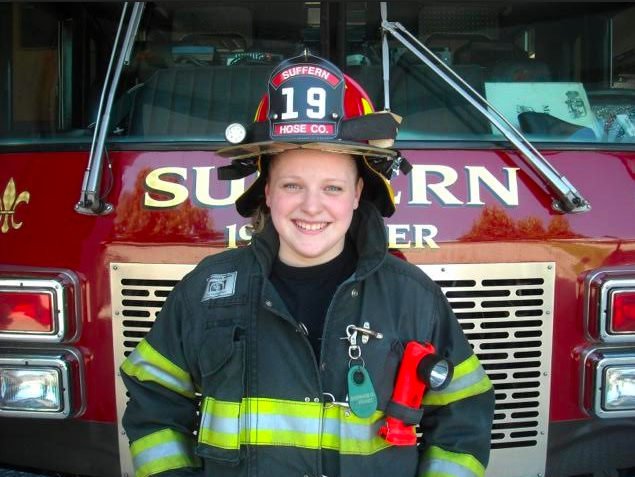
BY BARRY WARNER
Firefighters who fight structure fires have to deal with an additional challenge this week: the excessive heat wave. Firefighters wear heavy turnout gear that makes it difficult to stay cool. They have to be fully encapsulated with no area of skin exposed to blistering temperatures. Through mutual-aid or agreement with other departments, crews can be rotated to give the firefighters enough water to stay hydrated and rest. This helps keep firefighters maintain productivity during situations when the hard work must continue.
“Diane is one of the most motivated members of the Hose Company and always has a good attitude. In a profession that is dominated by males, she’s not afraid to get ‘down and dirty’, proving she’s no different than anyone else,” Captain Joe Bednarski said. “Diane has many relatives in the Suffern Fire Department, past and present, including her late father Frank, who as an ex-chief of the department. Despite having such a large family presence in the fire department, Diane has been able to create her own image, going above and beyond, creating a positive reputation.”
“I’m a member of the Firefighter Assist and Search Team (FAST). The rapid intervention team consists of two or more firefighters dedicated to the search and rescue of other firefighters in distress, because there’s always a danger of a ‘flashover’ when fighting fires in an apartment structure,” Diane France told the Rockland County Times. “We train on firefighter survival techniques or ways to get out of a fire if you’re stuck, such as using a rope to get out of the building or follow the hose line. We train on Monday nights to use a blindfold to drag a hose line through obstacles and avoid kinks in the line.”
“We have a lot of high-rises in Suffern including Good Samaritan Hospital and Esther Gitlow Towers,” she continued. “Training includes carrying a high-rise hose pack that allows one person to carry up to 150 feet of hose with nozzle and adapters for standard pipe hook-ups. We charge the line with water and practice that nothing gets stuck until we get into the apartment and this is difficult because there are so many twists and turns in the hose.”
“On the incident scene, the officers let you know what to do,” Diane said. “I like to be in action on the hose, where advancement of the hose line is critical in fighting the fire. When we arrive at a fire, an iPad is used to determine the locations of the hydrants. We’re very lucky in Suffern, because we have hydrants located every 200 feet. There are 750 gallons of water in the pumper fire trucks to charge the hose lines and then we hook up to the hydrants for an additional source of water. During the winter, water turns to ice, so we spread salt on the ice to keep the firefighter from falling.”
Flashover is the sudden involvement of a room or an area in flames from floor to ceiling caused by thermal radiation feedback. This is the energy of the fire being radiated back to the contents of the room from the wall, floor and ceiling. This radiation of energy to the contents of the room will raise all of the contents to their ignition temperatures and suddenly ignite.
Self-rescue skills involve incorporating an emergency rappel or following the hose line. Many fire departments use different types of descent devices. Firefighters should be equipped with a Class II Harness, 50 feet of personal escape rope, a descent device and carabiner clips for attachment purposes. After securing a reliable anchor point, the firefighter keeps tension on the rope and makes the way out the window, descending the rope until they’re on the ground. In the event firefighters become disoriented, they can find a hose line and use it to guide their way out. Depending on the direction of travel, firefighters will find either the nozzle on the end of a hose or find egress out of the structure. Some departments have arrows painted on their hoses, with the arrows pointing to the way out of the structure.
The first arriving company at a high-rise incident needs to park its vehicle out of the flow of traffic and enter the building with self-contained breathing apparatuses (SCBAs), 200 feet of hose with nozzles, standpipe adaptors and a set of irons. The first-in crew confirms the location of the fire, makes a report to the Incident Commander, uses the stairs to ascend to the fire-floor and begin attack operations.
“I volunteer because I like to help people,” Diane concluded. “I joined the Suffern Hose Company when I was 16 and became a junior member. It’s very much a family thing, as I grew up in this lifestyle. My grandfather was captain of the fire police and my father was an ex-chief and treasurer. In addition, four uncles, an older sister and a brother-in-law are active members.”
For information about volunteering for Suffern Hose Company #1, call 845-357-8841.

You must be logged in to post a comment Login